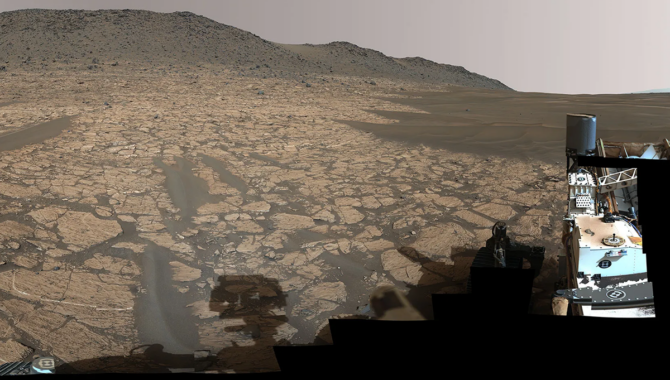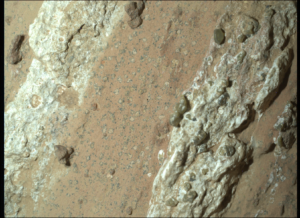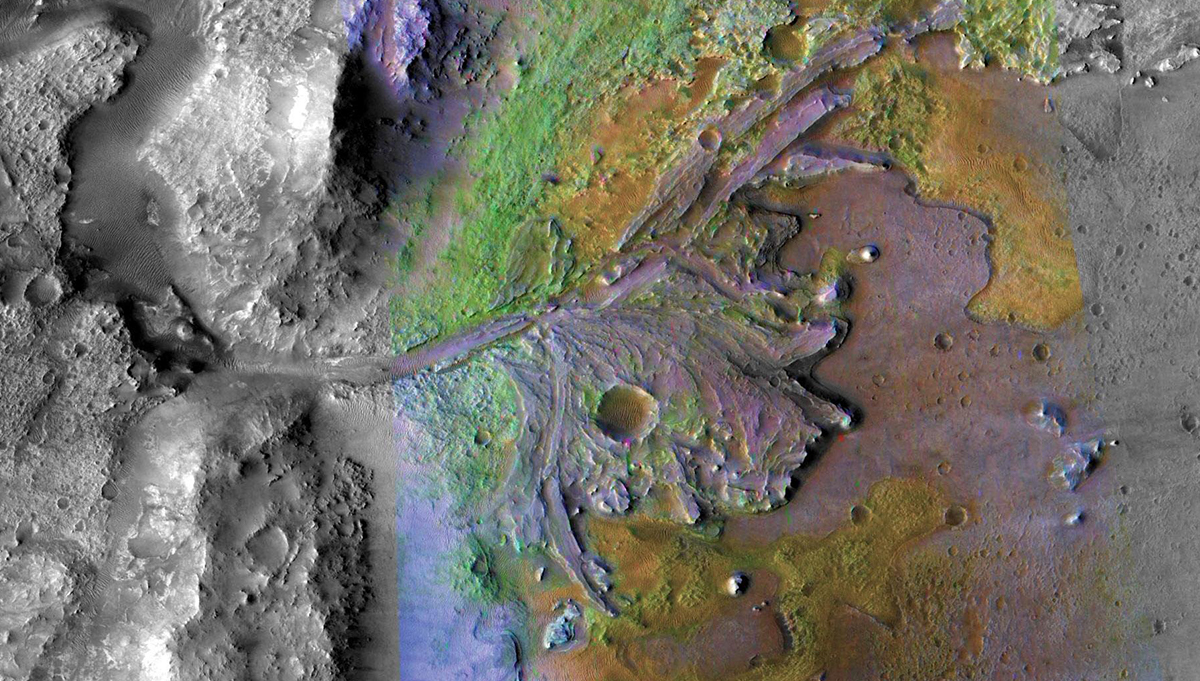
This view of a valley where water flowed billions of years ago was captured by NASA’s Perseverance rover using the Mastcam-Z instrument. A puzzling rock named “Cheyava Falls” is about 361 feet in front of the rover here and left of center. Credit: NASA
New research adds clues in the quest to learn what happened to ancient water on the planet and if it ever supported microbial life.
Ancient civilizations watched the sparkling red light in the night sky with fascination. They personified it as the god of war. They began recording observations of it more than 4,000 years ago. They noted it didn’t move in concert with other points of light and began plotting and predicting the movements of Mars, the “wandering star.”

This enhanced-color image from NASA Mars Reconnaissance Orbiter shows sand dunes trapped in an impact crater in Noachis Terra, Mars. Credit: NASA/JPL-Caltech/Univ. of Arizona
After many hundreds of years of scientific observation, the fascination with Mars continues. The planet has retained an aura of mystery, even as its place in the solar system and orbital dynamics became better understood. Owing to erroneous observations in the 1800s, science fiction writers began spinning fantastic tales about the planet as home to advanced civilizations, which gripped the public imagination for decades.
Exactly how fanciful those tales were became clear when NASA’s Mariner 4 spacecraft passed by Mars in July 1965. The first close-up images revealed a desolate landscape marked by ancient geological features. The surface was dry and bitterly cold at -148 degrees Fahrenheit, with a thin atmosphere.
NASA has sent 22 missions to Mars since Mariner 4, including four more Mariner spacecraft, and the Viking 1 and 2 missions, which included an orbiter and a lander. Currently, NASA has two orbital missions at Mars—the Mars Odyssey, which arrived in April 2001 and the Mars Reconnaissance Orbiter, which arrived in 2005. NASA is also contributing to the European Space Agency’s Mars Express orbiter, which arrived in 2003. Gathering data on the surface are NASA’s Curiosity and Perseverance rovers.
The science that has emerged indicates that approximately 3 billion years ago, Mars was more Earth-like, with warmer temperatures and periods of abundant surface water in transient lakes and streams, and perhaps a primitive ocean. “What became of this surface water?” is one of the key questions research teams are working to answer. Another is: “Did this water ever support microbial life on the planet?”

This view from the NASA Curiosity Mars rover shows an example of cross-bedding that results from water passing over a loose bed of sediment. It was taken at a target called Whale Rock within the Pahrump Hills outcrop at the base of Mount Sharp. Credit: NASA/JPL-Caltech/MSSS
In August, a team led by Vashan Wright, a geophysicist at the Scripps Institution of Oceanography at the University of California, San Diego, published a research brief in the journal Proceedings of the National Academy of Sciences. The team analyzed data from NASA’s InSight lander, which placed the first seismometer directly on the surface of Mars in December 2018. The rich data record from that instrument clarified the internal structure of Mars, revealing a larger-than-expected core of molten iron and lighter elements, and a crust between 15 and 25 miles thick, in three distinct internal layers.
Analyzing this data with rock physics models and a technique known as Bayesian inversion, the team examined many scenarios for what they saw in records of seismic waves and determined that they could best be explained if the planet’s mid-crust—between 7 to 13 miles deep—was “composed of fractured igneous rocks saturated with liquid water.” This intriguing possibility points to the value of gathering further data about the crust of Mars, its minerality, and composition, the authors wrote. “Our results have implications for understanding Mars’ water cycle, determining the fates of past surface water, searching for past or extant life, and assessing in situ resource utilization for future missions.”

NASA’s Perseverance Mars rover captured this image of a rock nicknamed “Cheyava Falls” on July 18, 2024. Credit: NASA/JPL-Caltech/MSSS
Earlier this year, in July, the science team exploring Jezero Crater with NASA’s Perseverance rover found a rock resting at the edge of an ancient valley where water flowed billions of years ago. They named the rock “Cheyava Falls,” after the tallest waterfall in the Grand Canyon. The rock is approximately 3.2 feet long by 2 feet wide and shaped like an arrow. It is marked by large white calcium sulfate veins, white splotches surrounded by black rings, and contains patches of olivine, a magnesium iron silicate common in Earth’s crust.
“Cheyava Falls is the most puzzling, complex, and potentially important rock yet investigated by Perseverance,” said Ken Farley, the mission’s project scientist, in a NASA press release. “On the one hand, we have our first compelling detection of organic material, distinctive colorful spots indicative of chemical reactions that microbial life could use as an energy source, and clear evidence that water — necessary for life — once passed through the rock. On the other hand, we have been unable to determine exactly how the rock formed and to what extent nearby rocks may have heated Cheyava Falls and contributed to these features.”
The team collected the mission’s 22nd core sample, and analyzed the rock with Perseverance’s SHERLOC instrument, which can detect mineral traces through Raman spectroscopy. The white spots surrounded by dark rings could indicate chemical reactions that released iron and phosphate.
“On Earth, these types of features in rocks are often associated with the fossilized record of microbes living in the subsurface,” said David Flannery, an astrobiologist and member of the Perseverance science team, in a NASA press release.
To learn more about NASA’s research and exploration of Mars, click here.









